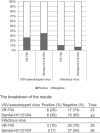Possible involvement of infection with human coronavirus 229E, but not NL63, in Kawasaki disease
- PMID: 24760654
- PMCID: PMC7166330
- DOI: 10.1002/jmv.23950
Possible involvement of infection with human coronavirus 229E, but not NL63, in Kawasaki disease
Abstract
Although human coronavirus (HCoV)-NL63 was once considered a possible causative agent of Kawasaki disease based on RT-PCR analyses, subsequent studies could not confirm the result. In this study, this possibility was explored using serological tests. To evaluate the role of HCoV infection in patients with Kawasaki disease, immunofluorescence assays and virus neutralizing tests were performed. Paired serum samples were obtained from patients with Kawasaki disease who had not been treated with γ-globulin. HCoV-NL63 and two antigenically different isolates of HCoV-229E (ATCC-VR740 and a new isolate, Sendai-H) were examined as controls. Immunofluorescence assays detected no difference in HCoV-NL63 antibody positivity between the patients with Kawasaki disease and controls, whereas the rate of HCoV-229E antibody positivity was higher in the patients with Kawasaki disease than that in controls. The neutralizing tests revealed no difference in seropositivity between the acute and recovery phases of patients with Kawasaki disease for the two HCoV-229Es. However, the Kawasaki disease specimens obtained from patients in recovery phase displayed significantly higher positivity for Sendai-H, but not for ATCC-VR740, as compared to the controls. The serological test supported no involvement of HCoV-NL63 but suggested the possible involvement of HCoV-229E in the development of Kawasaki disease.
Keywords: Kawasaki disease; human coronavirus 229E; human coronavirus NL63; neutralizing test.
© 2014 Wiley Periodicals, Inc.
Figures



References
-
- Anderson DG, Warner G, Barlow E. 1995. Kawasaki disease associated with streptococcal infection within a family. J Paediatr Child Health 31:355–357. - PubMed
-
- Catalano‐Pons C, Giraud C, Rozenberg F, Meritet JF, Lebon P, Gendrel D. 2007. Detection of human bocavirus in children with Kawasaki disease. Clin Microbiol Infect 13:1220–1222. - PubMed
Publication types
MeSH terms
Substances
LinkOut - more resources
Full Text Sources
Other Literature Sources
Medical

